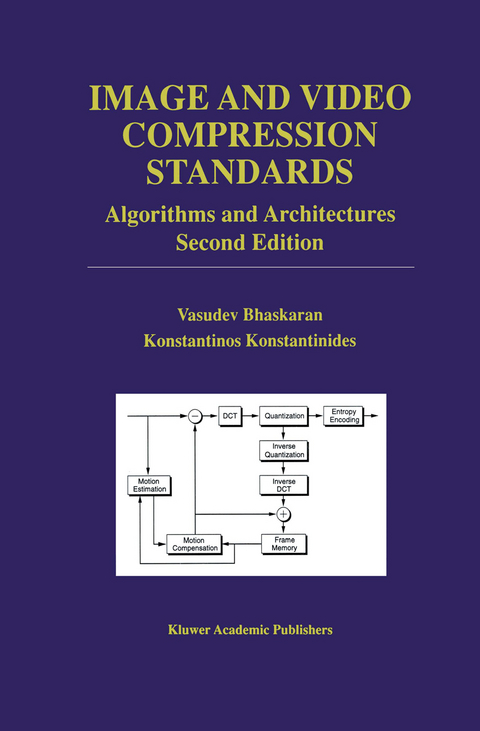
Image and Video Compression Standards
Springer-Verlag New York Inc.
978-1-4613-7842-6 (ISBN)
offers the latest developments in standards activities (JPEG-LS, MPEG-4, MPEG-7, and H.263)
provides a comprehensive review of recent activities on multimedia enhanced processors, multimedia coprocessors, and dedicated processors, including examples from industry.
Image and Video Compression Standards: Algorithms and Architectures, Second Edition presents an introduction to the algorithms and architectures that form the underpinnings of the image and video compressions standards, including JPEG (compression of still-images), H.261 and H.263 (video teleconferencing), and MPEG-1 and MPEG-2 (video storage and broadcasting). The next generation of audiovisual coding standards, such as MPEG-4 and MPEG-7, are also briefly described. In addition, the book covers the MPEG and Dolby AC-3 audio coding standards and emerging techniques for image and video compression, such as those based on wavelets and vector quantization.
Image and Video Compression Standards: Algorithms and Architectures, Second Edition emphasizes the foundations of these standards; namely, techniques such as predictive coding, transform-based coding such as the discrete cosine transform (DCT), motion estimation, motion compensation, and entropy coding, as well as how they are applied in the standards. The implementation details of each standard are avoided; however, the book provides all the material necessary to understand the workings of each of the compression standards, including information that can be used by the reader to evaluate the efficiency of various software and hardware implementations conforming to these standards. Particular emphasis is placed on those algorithms and architectures that have been found to be useful in practical software or hardware implementations.
Image and Video Compression Standards: Algorithms and Architectures,Second Edition uniquely covers all major standards (JPEG, MPEG-1, MPEG-2, MPEG-4, H.261, H.263) in a simple and tutorial manner, while fully addressing the architectural considerations involved when implementing these standards. As such, it serves as a valuable reference for the graduate student, researcher or engineer. The book is also used frequently as a text for courses on the subject, in both academic and professional settings.
1 Compression Fundamentals.- 1.1 Introduction.- 1.2 Background.- 1.3 Compression Taxonomy.- 1.4 Issues in Compression Method Selection.- 1.5 To Probe Further.- 2 Methods and Standards for Lossless Compression.- 2.1 Introduction.- 2.2 Preliminaries.- 2.3 Huffman Encoding.- 2.4 Huffman Decoding.- 2.5 Huffman Codes with Constrained Length.- 2.6 Constrained-Length Huffman Codes: Ad Hoc Design.- 2.7 Constrained-Length Huffman Codes: The Voorhis Method.- 2.8 Golomb and Rice Coding.- 2.9 Arithmetic Coding.- 2.10 Implementation Issues.- 2.11 Standards for Lossless Compression.- 2.12 New Work in JPEG: JPEG-LS.- 2.13 To Probe Further.- 3 Fundamentals of Lossy Image Compression.- 3.1 Introduction.- 3.2 Preliminaries.- 3.3 Basic Coding Schemes for Lossy Compression.- 3.4 DCT-based Coding.- 3.5 Fast Algorithms for the DCT.- 3.6 Rate-Distortion Performance of the DCT.- 3.7 To Probe Further.- 4 Fundamentals of Lossy Video Compression.- 4.1 Introduction.- 4.2 Video Coding Basics.- 4.3 Rate-Distortion Functions in Video Coding.- 4.4 Motion-Compensated Prediction.- 4.5 Algorithms for Motion Estimation.- 4.6 Motion Estimation Using Low Complexity Matching Criteria.- 4.7 Sub-pixel-Accurate Motion Estimation.- 4.8 Multipicture Motion Estimation.- 4.9 To Probe Further.- 5 The JPEG Standard.- 5.1 Introduction.- 5.2 DCT-based Coding.- 5.3 Processing of Color Images.- 5.4 Design of Quantization Tables.- 5.5 Entropy Coding.- 5.6 JPEG Modes of Operation.- 5.7 Implementation Issues.- 5.8 JPEG Extensions and Applications.- 5.9 To Probe Further.- 6 The MPEG Video Standards.- 6.1 Introduction.- 6.2 The MPEG-1 Video Standard.- 6.3 MPEG-1 Implementation Issues.- 6.4 The MPEG-2 Video Standard.- 6.5 The MPEG-4 Coding Standard.- 6.6 Future Directions: MPEG-7.- 6.7 To Probe Further.- 7 Video Teleconferencing Standards.- 7.1 Introduction.- 7.2 H.320 Video Teleconferencing.- 7.3 The H.261 Video Coding Standard.- 7.4 Implementation Issues.- 7.5 H.324 Video Teleconferencing.- 7.6 The H.263 Video Coding Standard.- 7.7 Future Directions.- 7.8 To Probe Further.- 8 Processing Requirements.- 8.1 Introduction.- 8.2 Measuring Complexity.- 8.3 Distributing the Load.- 8.4 To Probe Further.- 9 Risc and Dsp Cores.- 9.1 Introduction.- 9.2 The RISC Core.- 9.3 The DSP Core.- 9.4 RISC versus DSP.- 9.5 To Probe Further.- 10 Architectures for the DCT.- 10.1 Introduction.- 10.2 Vector Processing.- 10.3 Distributed Arithmetic for the DCT.- 10.4 Commercially Available DCT Processors.- 10.2 To Probe Further.- 11 Hardware for Motion Estimation.- 11.1 Introduction.- 11.2 Block Matching Using Linear Arrays.- 11.3 Hardware for One-bit Motion Estimation.- 11.4 Sub-pel Motion Estimation.- 11.5 Implementation Examples.- 11.6 To Probe Further.- 12 Hardware for Entropy Coding.- 12.1 Introduction.- 12.2 Encoder Implementation.- 12.3 Decoder Implementation.- 12.4 Variable-Length Coding in JPEG.- 12.5 To Probe Further.- 13 Implementation of JPEG Processors.- 13.1 Introduction.- 13.2 Data I/O and Memory Interface.- 13.3 Color Conversion.- 13.4 Commercially Available JPEG Processors.- 13.5 To Probe Further.- 14 Integrated Circuits for Video Codersc.- 14.1 Introduction.- 14.2 Video Signal Processors.- 14.3 Multimedia Coprocessors.- 14.4 Dedicated Coders.- 14.5 To Probe Further.- 15 Multimedia Enhancements for General Purpose Processors.- 15.1 Introduction.- 15.2 Generic Operations in Video Processing.- 15.3 Multimedia Enhancements in the HP-PA.- 15.4 Multimedia Enhancements in the UltraSparc.- 15.5 Multimedia Enhancements in the Intel Architecture.- 15.6 To Probe Further.- 16 Standards for Audio Compression.-16.1 Introduction.- 16.2 The G.72X Standards.- 16.3 Fundamentals of Perceptual Coders.- 16.4 MPEG Audio Encoding.- 16.5 MPEG Audio Decoding.- 16.6 The AC-3 Coding Standard.- 16.7 Future Directions in MPEG.- 16.8 Hardware Implementation of Audio Codecs.- 16.9 To Probe Further.- 17 Nonstandard Compression Techniques.- 17.1 Introduction.- 17.2 Vector Quantization.- 17.3 Subband Coding.- 17.4 Video Coding Schemes for the Desktop.- 17.5 To Probe Further.- A Color Transformations.- B Abbreviations and Symbols.- C Internet Directory.- References.
| Reihe/Serie | The Springer International Series in Engineering and Computer Science ; 408 |
|---|---|
| Zusatzinfo | XVI, 454 p. |
| Verlagsort | New York, NY |
| Sprache | englisch |
| Maße | 155 x 235 mm |
| Themenwelt | Informatik ► Grafik / Design ► Digitale Bildverarbeitung |
| Informatik ► Theorie / Studium ► Künstliche Intelligenz / Robotik | |
| Technik ► Elektrotechnik / Energietechnik | |
| ISBN-10 | 1-4613-7842-7 / 1461378427 |
| ISBN-13 | 978-1-4613-7842-6 / 9781461378426 |
| Zustand | Neuware |
| Haben Sie eine Frage zum Produkt? |
aus dem Bereich


